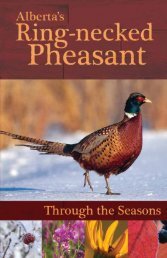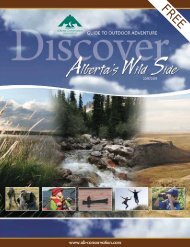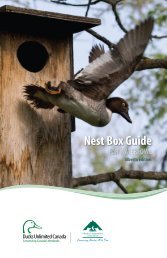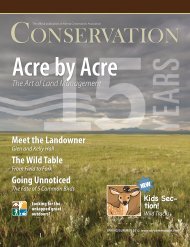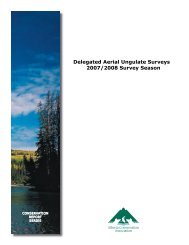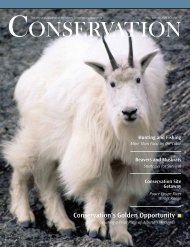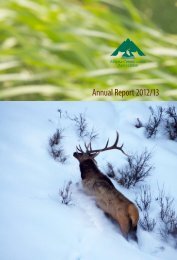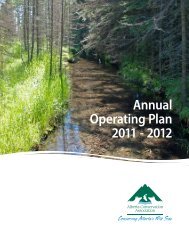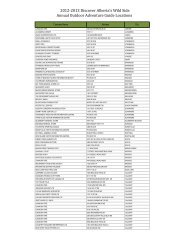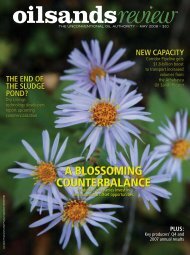Water-loving Weasels - Alberta Conservation Association
Water-loving Weasels - Alberta Conservation Association
Water-loving Weasels - Alberta Conservation Association
Create successful ePaper yourself
Turn your PDF publications into a flip-book with our unique Google optimized e-Paper software.
decreasing. In addition, while we know cougars<br />
can have important influences on populations of<br />
their prey, we do not know enough about what<br />
drives cougar predation to manage it effectively.<br />
Lastly, oil and gas, forestry, and residential<br />
development are increasingly influencing<br />
<strong>Alberta</strong>’s landscape, but we do not know how<br />
cougars are responding to these changes.<br />
The Clearwater County<br />
study area<br />
We selected a 16,000 km 2 portion of the<br />
Clearwater County (bordering Banff and Jasper<br />
National Parks in the<br />
west and Rocky Mountain<br />
House and Caroline to the<br />
east) as our study area. An<br />
incredible diversity of large<br />
carnivores and ungulates<br />
live in the region (wolves,<br />
cougar, black bear, grizzly<br />
bear, white-tailed deer,<br />
mule deer, elk, moose,<br />
bighorn sheep, feral<br />
horses, mountain goats<br />
and caribou), creating<br />
a fascinating range of<br />
potential interactions<br />
among predator and prey.<br />
The number of humancougar<br />
conflicts was<br />
increasing when the study<br />
began back in 2004. This<br />
included both an increase in cougar sightings<br />
and complaints of livestock and pets killed by<br />
cougars. We noted that both industrial and<br />
residential activity were extensive in parts of the<br />
study area and yet almost completely absent in<br />
places, such as the Bighorn Backcountry. Such a<br />
gradient proved useful for examining the effects<br />
of humans on cougars. Cougar hunting quotas<br />
had increased dramatically since the early<br />
1990s, but populations of sheep, elk and caribou<br />
were declining. The decline of bighorn sheep<br />
populations at Ram Mountain was blamed on<br />
cougars, which made the Clearwater County the<br />
ideal place to study cougars.<br />
A total of 44 cougars were captured and<br />
radio-collared between December 2005 and<br />
August 2008, some more than once, totaling 57<br />
deployments. Most cougars were collared with<br />
Global Positioning System (GPS) radiocollars.<br />
Nearly twice as many females (29) were captured<br />
as males (15). The GPS collar technology allowed<br />
us to keep track of the cougars closely, regardless<br />
of the season or the location of a cougar’s home<br />
range. The collared cougars were monitored for<br />
a total of 12,080 days and we obtained 47,866<br />
cougar locations<br />
In addition to increasing conflicts with people,<br />
the number of human-caused cougar mortalities<br />
(hunting, accidental snaring, vehicle strikes) has<br />
also been rising since the early 1990s, and there<br />
is a general impression that cougar populations<br />
have increased in <strong>Alberta</strong> over recent decades.<br />
This may very well be the case.<br />
Cougars tend to bury their prey with available debris.<br />
I found a density of 2.9 cougars for every<br />
100 km 2 , within an intensively surveyed 294<br />
km 2 portion of my study area near the town of<br />
Nordegg. A 20-year-old provincial management<br />
plan suggested one cougar per 100 km 2 in the<br />
same region. Either the cougar population has<br />
gone up, or the original density estimate was<br />
too low. Whether or not the population has<br />
changed, cougar hunting quotas have increased<br />
substantially in response to the perception<br />
of change caused by increased sightings and<br />
depredation.<br />
The majority of the collared cougar mortalities<br />
during my study were caused by hunting.<br />
However, accidental snaring at wolf bait stations<br />
accounted for one-third of the deaths. Since the<br />
survival of the radio-collared adult cougars was<br />
low (67 per cent annually), hunting and snaring<br />
rates may be limiting the cougar population in<br />
west-central <strong>Alberta</strong>.<br />
Cougar interactions<br />
with prey<br />
Another important element of the study was<br />
to gather information on how cougars interact<br />
with their prey in areas that had several other<br />
species of prey and predators. We know that<br />
predation is often implicated as a major factor<br />
driving population declines. Some stakeholders<br />
have called for predator control to protect<br />
these ungulate populations. And in some cases,<br />
predator control is being implemented as an<br />
ongoing management strategy. One example is<br />
the annual wolf cull near Grand Cache, which<br />
occurs to protect the Little<br />
Smokey Caribou herd.<br />
By carefully studying<br />
cougar predation, we<br />
hope to better understand<br />
when, where, and how<br />
cougars impact their prey.<br />
This knowledge will help<br />
us find better strategies<br />
for managing cougar<br />
predation. Clusters of<br />
the GPS collared cougars<br />
were visited to monitor<br />
the number and kinds of<br />
prey taken. This provided<br />
us with a total of 7,823<br />
monitored cougar days<br />
and led to more than 1,400<br />
predation and scavenging<br />
sites. As a result, we have<br />
the most extensive dataset on cougar predation<br />
anywhere in the world.<br />
Kyle Knopff<br />
Deer proved to be the prey of choice for the<br />
cougars in the study area. But individual animals<br />
appear to focus on certain types of prey, such as<br />
moose, feral horses, elk or bighorn sheep. Males<br />
killed larger prey than their female counterparts.<br />
One large collared male, weighing over 180<br />
pounds, killed 17 feral horses, eight moose, five<br />
elk, five deer, three beaver, and one other cougar<br />
between February 18 and December 4, 2006.<br />
Clearly he focused his predatory efforts on larger<br />
prey, particularly feral horses.<br />
This specialist behavior has important<br />
implications for management. We know that<br />
if an isolated ungulate population of bighorn<br />
sheep is declining as a result of specialist cougar<br />
predation, simply removing cougars from the<br />
vicinity might not have the desired effect. If the<br />
individual responsible is missed, the cougar<br />
population would have been unnecessarily<br />
We found that less than one per cent of the radio-collared cougar in the Clearwater County killed domestic animals.<br />
20<br />
<strong>Conservation</strong> Magazine • Spring/summer 2009





